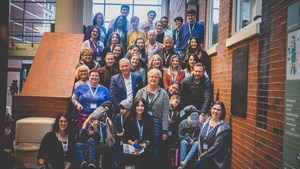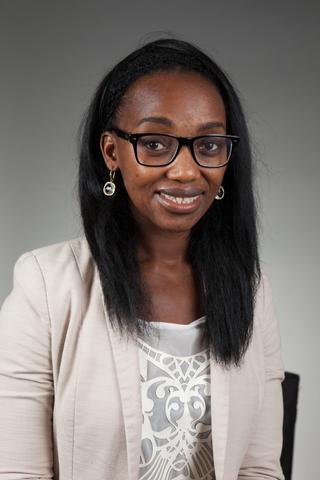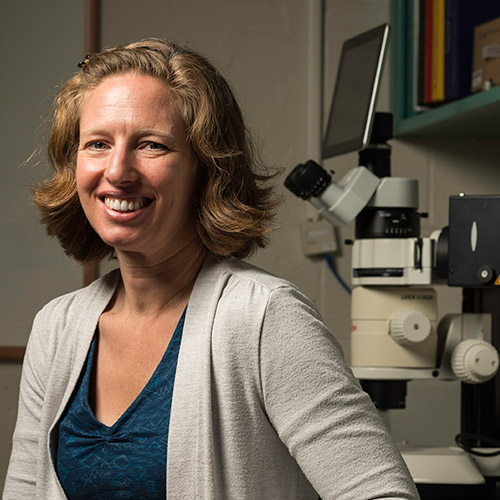WinterSpring2020
 In November, the Del Monte Institute welcomed patients and families, clinicians, researchers, and community members to the inaugural Rett Syndrome Education and Research Day, led by Tufi Brima, Ph.D., a research assistant professor in the URMC Cognitive Neurophysiology Lab. Rett Syndrome Research & Education Day is scheduled for October 17, 2020.
In November, the Del Monte Institute welcomed patients and families, clinicians, researchers, and community members to the inaugural Rett Syndrome Education and Research Day, led by Tufi Brima, Ph.D., a research assistant professor in the URMC Cognitive Neurophysiology Lab. Rett Syndrome Research & Education Day is scheduled for October 17, 2020.
Top
 Tufikameni Brima, Ph.D. has dedicated much of her career to understanding how brain processes differ in children and adults with genetic neurodevelopmental disabilities. Brima is a research assistant professor in the Cognitive Neurophysiology Laboratory (CNL) in the Del Monte Institute for Neuroscience and her work is centered on two rare genetic disorders — Rett syndrome and Batten Disease.
Tufikameni Brima, Ph.D. has dedicated much of her career to understanding how brain processes differ in children and adults with genetic neurodevelopmental disabilities. Brima is a research assistant professor in the Cognitive Neurophysiology Laboratory (CNL) in the Del Monte Institute for Neuroscience and her work is centered on two rare genetic disorders — Rett syndrome and Batten Disease.
Brima’s research is focused on developing objective quantitative measures of brain function in patients, where standard cognitive evaluation is almost impossible to administer. These measures will enable scientists and clinicians to accurately track disease progress and the effect of current and future therapies. She uses electroencephalogram (EEG) as tool to explore cognitive processing and language comprehension in non-verbal individuals with these rare disorders. She hopes that in addition to objective measures of brain function, her findings will also contribute towards the development of better communication devices for these individuals.
“The advantage of using EEG is that it provide us with an effective tool that is inexpensive, portable, and easy to administer. If we can find a way to routinely use EEG as part of our screening protocols especially in non-verbal patients, it would be very helpful in terms of accurately assessing the progression of their disease, and in turn, making certain that they get the proper medication,” Brima said.
Collaborating with the University of Rochester Batten Center, CNL is studying how the brain of a person with Batten disease responds to different information. It is an effort to identify surrogate biomarkers, which could help fellow researchers, understand more about how genetic mutations of this disease affect brain processing and disease progression. This knowledge will, in turn, facilitate the development of effective therapies.
While dedicated to both disorders, Brima learned early on she may have a personal connection to Rett syndrome. Growing up in Namibia, Brima believes her first experience with the syndrome was within her own family. “Looking back, I believe one of my aunts had a child with Rett syndrome.” She made the connection as a post-doctoral associate when she met her first patient with Rett syndrome who reminded her of that child. The connection instantly made her work personal with a mission beyond her initial intentions. “I want to go back home one day and inform people, educate people that it's not the woman's fault that a child is born with a genetic disorder. That they have a mutation. That they are not as intellectually capable as other children. I want to educate the women there that they do not need to be outcasts because they have a child that is challenged intellectually, or they're not able to walk, or are wheelchair bound.”
Until that day, Brima finds inspiration in the families she meets and works with at the University who are impacted by these genetic disorders. “To me it makes my work so much more meaningful because I know that even though what I'm doing right now might not impact the families that are coming in for studies directly, it will affect at least one of them along the line in the future.”
In November 2019, Brima led Rett Syndrome Education and Research Day at the Medical Center. The first of what will become an annual event that brought together patients and families along with clinicians, researchers, and community members to connect and cultivate a sense of support and belonging.
Saturday, Feb. 29 is International Rare Disease Day. Brima is one of many researchers at the University of Rochester who are studying rare neurological disorders.
Top

Susan Hyman, M.D.
Early intervention for symptoms associated with autism spectrum disorder – even before the condition is formally diagnosed – is critical for helping families improve outcomes for their children, according to updated recommendations from the American Academy of Pediatrics (AAP).
The new clinical report to guide diagnosis and care of children with autism is the AAP’s first in 12 years and reflects changes in how autism is diagnosed and treated. Specific autism screenings are recommended at 18 and 24 months, at the same time as typical well-child visits. During these visits, pediatricians gauge milestones reflecting social communication, which could provide early signs of autism, according to Susan Hyman, M.D., lead author of the report and professor at the University of Rochester Medical Center’s Golisano Children’s Hospital.
“Social milestones like eye pointing to indicate interest, pointing to share interest and engaging in pretend play are not milestones that most parents are looking for, and might miss if not specifically asked about in the form of screening,” said Hyman, past chair of the AAP’s subcommittee on Autism.
Identification of Co-Occurring Conditions Important
 In addition to social milestones, pediatricians are now encouraged to screen for conditions that often occur in tandem with autism, such as ADHD, anxiety, food selectivity, and sleeping disorders. Identification of these conditions is important because children may benefit from specific interventions, according to Hyman.
In addition to social milestones, pediatricians are now encouraged to screen for conditions that often occur in tandem with autism, such as ADHD, anxiety, food selectivity, and sleeping disorders. Identification of these conditions is important because children may benefit from specific interventions, according to Hyman.
“Eating and sleeping issues can be identified long before autism is diagnosed,” she said, “and you don’t need to wait for an official diagnosis to begin treatment.”
While universal screening could lead to an increased number of children referred for autism diagnostic evaluations, these screenings will still have an overall benefit to child health, noted Hyman. “If the concerns are not due to autism, the other developmental problems can be addressed. Almost all children who screen positive have symptoms worthy of further evaluation and intervention even if they do not get diagnosed with autism.”
Continued surveillance through school age increases the likelihood of catching harder-to-diagnose cases. “Some children with more typical language skills may not be identified until they enter school and social requirements are greater,” Hyman said. Hyman also encourages pediatricians to listen to parents’ concerns. “The current tests used for screening toddlers are more accurate when used with a follow-up interview with the child’s caregivers.”
Since 2007, the prevalence of autism has increased from one in 155 children to one in 59. “Odds are, every child care provider has a child with autism in their office, and the reason we do these reports is to pull together useful information for the primary care providers to deliver the needed care for the child and their family,” says Hyman.
Shared-Decision Making Can Help Interventions
Research has shown that families can help children develop adaptive skills – such as engaging in strategies to capture a child’s attention and encourage communication – and improve outcomes with early interventions. Hyman emphasizes that doctors should engage families in the decision-making process by providing them with the information and options they need to help plan interventions.
“In many cases, listening to what parents value is just as important as making recommendations for interventions based on scientific evidence,” she says. “Families may prioritize issues that the provider might not have considered, like ‘can you help me with my child’s wandering?’ ‘Can you give me information on how to handle puberty?’ ‘How do I transition my teenager to adult services?’”
Shared decision making is essential because few cases of autism are the same, according to Hyman. While the core symptoms include social communication problems and restrictive and repetitive behaviors, the disorder varies considerably given the co-occurrence of other conditions: “We have a saying: ‘if you’ve seen one person with autism you’ve seen one person with autism,’” she says.
While the autism spectrum has a lot of variability, Hyman expects that the new report will help advance community-based clinical care and allow for more targeted treatment. Hyman also assures parents that pediatric training in identifying and treating autism has become standard during the past decade.
“There has been a major effort since 2007 to train pediatricians to recognize the developmental and behavioral difference that can be seen and reported in children with autism,” she says. “And all pediatricians can refer children to Early Intervention (0-3 years) or the school system (over 3 years) for cognitive and language testing and to begin services while awaiting a formal diagnosis.”
Top
 Construction is underway on the largest children’s mental health ambulatory service in the region. The Golisano Pediatric Behavioral Health and Wellness building will be the new home and primary outpatient location for Golisano Children’s Hospital’s Pediatric Behavioral Health and Wellness program. The $12.3-million 36-thousand-square-foot facility will have space for outpatient and partial hospitalization services. This will double the space currently being used by the program, which helps patients with depression, anxiety, psychosis, substance abuse, post-traumatic stress disorder, and other behavioral and emotional conditions. These early intervention approaches help ensure timely care and reduce the need for more intensive, inpatient hospital care. This building will also expand the number of patients in the partial hospitalization program by 50 percent; the waiting list is up to 80 youth during the school year.
Construction is underway on the largest children’s mental health ambulatory service in the region. The Golisano Pediatric Behavioral Health and Wellness building will be the new home and primary outpatient location for Golisano Children’s Hospital’s Pediatric Behavioral Health and Wellness program. The $12.3-million 36-thousand-square-foot facility will have space for outpatient and partial hospitalization services. This will double the space currently being used by the program, which helps patients with depression, anxiety, psychosis, substance abuse, post-traumatic stress disorder, and other behavioral and emotional conditions. These early intervention approaches help ensure timely care and reduce the need for more intensive, inpatient hospital care. This building will also expand the number of patients in the partial hospitalization program by 50 percent; the waiting list is up to 80 youth during the school year.
The goal is to also add intensive outpatient services to the building. This will allow children receive a higher level of care than traditional outpatient services, but patients can attend their regular school and live at home.
The Del Monte Institute for Neuroscience is looking forward to the opportunity to bring research into the building. This will give neuroscientists ready access to study participants in a setting patients will already be visiting.
The building is scheduled to open in summer of 2020.
Top
Farran Briggs, Ph.D., joined the Del Monte Institute for Neuroscience in 2017 as an associate professor in the Departments of Neuroscience, Brain and Cognitive Sciences, and the Center for Visual Sciences. She received her B.A. in Biology from Dartmouth College and Ph.D. in Biology from the University of California, San Diego. Her work focuses on neuronal circuits in the visual system, and how attention affects the brain’s ability to process visual information.
Tell us a little bit about your research.
 FB: I am a vision neuroscientist. Broadly speaking, the questions that most interest me involve trying to understand how specific neuronal circuits in the early visual system encode visual information. I am also interested in how things like attention change the way that visual information is encoded in neuronal circuits. I am always interested in connecting structure with function. So every time I study a neural circuit, I want to understand the cellular components of that circuit: what is the morphology and physiology of each component neuron? What is the conductivity among neurons? The ultimate goal is to understand the causal role of identified neuronal circuits in vision. Malfunctions in some of these neuronal circuits in the early visual system could be implicated in a variety of diseases including sensory hypersensitivity and even Autism Spectrum Disorder (ASD). Other potential translational applications pertain to attention deficits that are components to many neuropsychiatric disorders.
FB: I am a vision neuroscientist. Broadly speaking, the questions that most interest me involve trying to understand how specific neuronal circuits in the early visual system encode visual information. I am also interested in how things like attention change the way that visual information is encoded in neuronal circuits. I am always interested in connecting structure with function. So every time I study a neural circuit, I want to understand the cellular components of that circuit: what is the morphology and physiology of each component neuron? What is the conductivity among neurons? The ultimate goal is to understand the causal role of identified neuronal circuits in vision. Malfunctions in some of these neuronal circuits in the early visual system could be implicated in a variety of diseases including sensory hypersensitivity and even Autism Spectrum Disorder (ASD). Other potential translational applications pertain to attention deficits that are components to many neuropsychiatric disorders.
What brought you to the University of Rochester?
FB: I was a faculty member at the Geisel School of Medicine at Dartmouth for six years before I came to UR. My reasons were simple: for vision research in highly visual animal models, UR is one of the best institutions in the world. The Center for Visual Science (CVS), which has one of the longest running core grants and training grants for vision research in the country, includes an unprecedented number of faculty studying vision at all levels from the optics of the eye to visual cognition. Additionally, there’s a concentration of research at UR involving similar animal models and techniques to those I use in my research. I’m surrounded by an amazing community of people who are doing similar things to me, which was not the case previously.
Do you have a favorite piece of advice from your own mentor, or someone who has inspired you in your career?
FB: Starting out as a new PI is really challenging. It’s trial by fire when you’re a new faculty member and sometimes you feel that if your experiments don’t work every day, you’re not going to make it. I went through a difficult phase during my first couple of years, where I would constantly question whether I was good enough to make this career work. At a particularly low point, I called up my postdoc advisor, Marty Usrey, for advice. He told me that he had no doubt that I have what it takes, but he also said that I needed to be sure that I felt the same about myself. He told me to evaluate whether what I was doing made me happy, because if I get to a point where I’m unhappy, then it’s time to consider alter- natives. That was really good advice. In the end, what matters most is that you’re happy and that you’re doing something you love. I think I really needed to hear that in that moment.
What do you like to do for fun outside of the lab?
FB: That is a fun question, although my answer is a little sad because my participation in my non-work activities has dwindled over the years. I’ve always been an athlete and participated in different types of sports, and when I was a graduate student and a postdoc, I got excited about triathlons. I loved the training; long solo rides and runs are such a great anti- dote to science, which is cerebral and detail oriented. Those runs and rides were meditative, a fantastic way to switch my mind into a different mode over a long period. The downside was the amount of training required, up to 40 hours per week. Partway through my postdoc, I realized this time commitment was not sustainable. I still love to ride my bike, run and swim, though, and I would love to get back into triathlons someday. Maybe when I’m 80.
Any final thoughts you would like to share?
FB: I’m really excited about the great potential for new collaborations at UR. I want to test my hypothesis that even some of the early circuits in the visual system might be implicated in sensory hypersensitivity. At UR, we’re surrounded by experts on ASD and other developmental disorders and I would love to keep developing this project and potential collaborations with PIs studying these disorders in humans. There’s a lot of potential.
Top
 Each day, thousands of young children with a diagnosis of autism spectrum disorder (ASD) receive therapy to address deficits in communication, social interaction, and engagement. Commonly referred to as Early Intensive Behavioral Intervention (EIBI) or Applied Behavior Analysis (ABA), this approach has been found to be effective for increasing adaptive behaviors and decreasing any challenging behavior a child may exhibit. EIBI often requires an intensive time commitment. Children often receive services for 20 or more hours per week, and this can be burdensome to children and families. Despite decades of research on this treatment approach, little is known about how to tailor interventions systematically or how to precisely apply different doses of intervention to meet the individual needs and responses of any one child.
Each day, thousands of young children with a diagnosis of autism spectrum disorder (ASD) receive therapy to address deficits in communication, social interaction, and engagement. Commonly referred to as Early Intensive Behavioral Intervention (EIBI) or Applied Behavior Analysis (ABA), this approach has been found to be effective for increasing adaptive behaviors and decreasing any challenging behavior a child may exhibit. EIBI often requires an intensive time commitment. Children often receive services for 20 or more hours per week, and this can be burdensome to children and families. Despite decades of research on this treatment approach, little is known about how to tailor interventions systematically or how to precisely apply different doses of intervention to meet the individual needs and responses of any one child.
Recent research suggests that EIBI may be effective when delivered at a lower intensity and with systematic emphasis of developing specific skills for some children. To investigate this, the Department of Defense has provided $7 million in funding to better understand what dose and components of EIBI is most effective for which children. Military families have unique stressors and lifestyle needs that may include planned relocation and the need to transfer services to new providers. This study will advance current knowledge on how to best implement behaviorally-based interventions for young children with ASD by examining the impact of interventions on both children and families.
Children newly diagnosed with an autism spectrum disorder, ages 1½ to 5 years of age and referred for ABA through Tricare in North Carolina, Ohio, and Tennessee may be eligible to participate in this landmark study. Clinicians already providing EIBI through Tricare in these locations are working together to examine the interventions. Partners in this project include the May Institute (site Principal Investigator and team Clinical Implementation lead Cynthia Anderson, PhD), the Cleveland Clinic Children’s Center for Autism (site Principal Investigator and team Scientific Director, Cynthia Johnson, PhD), Nationwide Children’s Hospital (site Principal Investigator Eric Butter, PhD), and Vanderbilt University Medical Center (site Principal Investigator Zachary Warren, PhD). This project is being coordinated through the University of Rochester School of Medicine by a team of researchers who were led by Tristram Smith, PhD; a long-time investigator of the impact of early behavioral interventions, until his untimely death in 2018 (Rochester Principal Investigator, Susan Hyman, MD). The collaborative research team includes Beth Ellen Davis, MD who will provide guidance on the unique needs of children who are military dependents.
Resources that may help military families affected by autism learn more about autism and services through the lifespan include https://www.operationautismonline.org/ and https://www.autismspeaks.org/support-military-families in addition to local autism support agencies.
Top